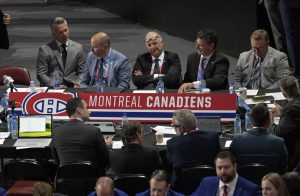The 2010 NHL draft will always be remembered for two tantalizing, elite prospects battling each other for the right to be called the first overall pick: Taylor Hall and Tyler Seguin. While most drafts have an Auston Matthews, Connor McDavid or some other consensus favourite, 2010 was a year that NHL scouts and fans could truly engage in a legitimate debate about who will be the better player.
A look back at the Taylor Hall vs. Tyler Seguin debate
Hall was wrapping up one of the greatest junior careers the OHL had ever seen. The left-winger led the powerhouse Windsor Spitfires to back-to-back Memorial Cup championships, picking up two Memorial Cup MVPs, two OHL first all-star team nods, and a scoring title along the way.
Seguin made his bid for first overall by winning the OHL’s Most Outstanding Player Award, and earning a spot on the CHL 1st first all-star team. His performance had scouts drooling over him, and he entered the 2010 draft ranked top among North-American skates by Central Scouting. After months of speculation, the Edmonton Oilers stepped up to the podium, and went against the Central Scouting Rankings. With the first-overall pick, they selected Hall.
The debate about who turned out to be the superior talent lives on even 10 years later. Fan’s of Hall and Seguin each have a strong case to make and a definitive answer may never truly emerge. After starting their careers on teams headed in totally opposite directions, Seguin and Hall now find themselves as the centerpiece of a promising lineup. With both players entering the tenth season of their incredible careers, it’s time to revisit the question that had everybody talking: Hall, or Seguin?
The Early Years: Taylor Hall
Hall began his career with the Oilers and became the beacon of hope for a franchise that was long removed from their glory days. Along with Sam Gagner and Jordan Eberle, Hall lead the charge offensively in his rookie season, finishing 2nd on the team with 42 points in only 65 games.
Hall was a very effective player from day one. He drove possession and pushed the play as an 18-year-old on a very lean Oilers lineup, finishing with a 5.4 relative corsi-for. That number only increased to an 8.4 relative corsi-for by his third season, as he broke the “point-per-game” threshold for the first time in his career. The next season, Hall finished with 80 points. He had become the go-to guy on the roster, eclipsing over 20 minutes of ice time per game.
The Early Years: Tyler Seguin
Seguin benefited from joining a championship Boston Bruins roster, thanks to the then Toronto Maple Leafs GM Brian Burke gifting the Bruins the 2nd overall pick. Seguin saw more sheltered useage than Hall, averaging just over 10 five-on-five minutes per game. After a rather ineffective rookie season, recording 22 points and a sub-50 corsi-for, Seguin split time between the press box and the third line during the Bruins run to the Stanley Cup, picking up 7 points in 13 post-season games along the way.
In his sophomore season, Seguin became a bonafide NHL star. He finished 10th in the league in points-per-60 and led the Bruins in scoring. This all came while playing on the wing despite Seguin being a natural centre. He continued to be a possession monster and elite offensive threat throughout his time with the Bruins. He improved enough to lead the team in relative-corsi by his third year, an impressive feat on a team that has Patrice Bergeron. The Bruins made another Cup run that year, and Seguin began to cement himself as a cornerstone of a Stanley Cup calibre team.
The Trade: Taylor Hall
Taylor Hall, bless his soul, played on some bad teams early in his career. The 2010-2016 Oilers were a fever dream, and the winger’s ability was no match against managements complete ineptitude. Hall spent his final season in Edmonton next to an emerging Leon Draisaitl (one of the few prospects the Oilers didn’t screw up). The effect Taylor had on the young centre was critical, as Draisaitl’s numbers plummeted when removed from Hall’s line.
Hall continued to drive play on another disappointing Oilers roster. He lead the team in scoring and finishing with the second best relative corsi-for on the roster, behind super-rookie Connor McDavid. After missing the playoffs once again, Oilers GM Peter Chiarelli pulled the trigger on a deal that sent Taylor Hall to the New Jersey Devils, in exchange for Adam Larsson.
The Trade: Tyler Seguin
Tyler Seguin’s last season in Boston was interesting. After a shortened regular season, Seguin’s Bruins found themselves in another Stanley Cup Final, where they ultimately lost to the Chicago Blackhawks. After being a passenger on the 2011 team, Seguin was a key player in 2013, averaging over 16 minutes of ice time in each game during the postseason. He made several headlines throughout the playoffs, but for all the wrong reasons.
The problems began with allegations of partying on the road during Boston’s first-round series against the Maple Leafs. By the time rumours of him being locked in his hotel room by coaches and management surfaced, the spotlight on Seguin only intensified. He fell out of favour with then head coach Claude Julien, who relegated Seguin to the third line. He finished the playoffs with a single goal and 8 points through 22 games, putting an exclamation mark on a tumultuous two-month span.
Despite experiencing one of the most spectacular runs of terrible shooting luck (1.6 percent), and maintaining strong possession numbers, Seguin’s playoff performance convinced management that he was expendable. After a lengthy debate that was captured in this viral, cringeworthy YouTube video, Peter Chiarelli (He strikes again!) found a trade partner in the Dallas Stars. The Bruins traded Seguin for a package centred around Loui Eriksson and Reilly Smith.
Thriving on New Teams: Taylor Hall
It seemed like Hall couldn’t catch a break. The Devils were on the downswing, and Hall missed the playoffs in his first season with his new club. This extended his playoff drought to seven years. On the ice, Hall was getting adjusted to new coach and linemates, and despite his points-per-game dropping, Hall’s possession numbers remained strong. In his first year with New Jersey, he recorded a Corsi-for of 52.2 percent.
New Jersey got to work in the summer and surrounded Hall with a supporting cast. It paid off big time. With first overall pick Nico Hischier and prized college defenceman Will Butcher in the fold, the Devils were the surprise team of the 2017-18 season. Hall enjoyed a breakout campaign, capturing the Hart Trophy and making the playoffs for the first time in his career. His season of the ages included an absurd 26-game point streak and finishing with 41 more points than the second-leading scorer on the Devils roster. He accomplished all of this while pushing the play in the Devils favour despite facing tough competition, with a five percent relative Corsi-for.
Injuries limited Hall’s 2018-19 season to 33 games, but he still managed 37 points in that span. In his first three seasons in New Jersey, Hall has developed into a true superstar, putting up 183 points in 181 games. It is hard to find another player who has a bigger stake in his team’s success, as evidenced by New Jersey’s playoff hopes plummeting once Hall got injured last season.
Thriving on New Teams: Tyler Seguin
Seguin had a much smoother transition in his first year with the Stars. He smashed his career-high with an 84 point effort next to his new linemate, Jamie Benn. Being moved back to centre severely helped Seguin’s success. Dallas lacked the horses up the middle that Boston had, and Seguin seized the opportunity on his new team, becoming the team’s top-line centre. His average ice time shot up by almost two-and-a-half minutes each game, and his offensive zone starts increased by 3.7 percent. The 22-year-old continued to thrive, as newly acquired head coach Lindy Ruff gave him more responsibility. Dallas went on to surprise a lot of pundits and make the playoffs in 2014.
Throughout his tenure in Dallas, Seguin has become one of the most consistent scorers in the league. His 1.197 goals-per-60 in the last three seasons ranks ahead of big-name snipers such as Phil Kessel and Joe Pavelski. Seguin has missed the 30-goal mark only once in a Stars uniform. Dallas has relied on Seguin and Benn to produce offensively and play against opponent’s top lines for seven seasons now and the duo has lived up to the task so far. They are largely responsible for Dallas making the playoffs three times in six seasons, despite playing in a very competitive division.
So Who is Better?
As both players step on the ice for their 10th season, it is hard to distinguish a clear winner between the two. Seguin has the ring, Hall has the hardware. Both have faced adversity, and both have thrived in new surroundings. The answer is no more clear than it was back in 2010.
The Case for Taylor Hall
Hall has faced more injuries and encountered less team success than Seguin. While the quality of his teammates and injury luck are out of his control, Hall continues to be a dynamic player. His career relative corsi-for of 4.2 percent is indicative of that fact, and that number is even more important when backed-up by the fact that Hall has played for some very bad Edmonton and New Jersey teams. He went from being a very good player on the Oilers to a great player with the Devils, thanks to an improved supporting cast around him. His 2018 MVP season was the highlight of his career, but Hall has also been an elite talent in his two other seasons with the Devils. He has done this all despite playing in less ice time on average than Seguin has.
The Case for Tyler Seguin
Seguin has been the top threat of some very good Dallas teams after the trade from Boston. He has become a very consistent scorer, having finished a season with no less than 72 points since becoming a Star. Seguin has built a reputation as one of the top goalscorers in the game, with the eighth-most tallies in the last six seasons. Seguin has been a positive possession player every year since he was a sophomore. While he may not have have the major accolade, the more consistent player of the two has been Seguin.
And the winner is…
So what is the verdict? It is almost too close to call. Despite having worse possession numbers, Hall has impacted possession relative to his teammates to a higher degree than Seguin. Hall playing on worse teams contributes to this. It leads to a larger responsibility to carry the play, something that he has done throughout his career. Hall also gets the advantage in points per game (.91 vs .87). While that could be attributed to burdening a larger share of the offensive responsibility relative to Seguin, both players start an identical amount of their shifts in the offensive zone. All things considered, Hall gets the edge by a hair over Seguin in this classic debate.
Main Photo:






